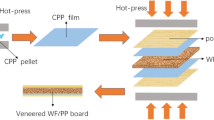Abstract
This study evaluated surface characteristics and overlaying properties of wood plastic composite (WPC) panels made from dry-blended rubber wood fiber-polypropylene (PP) powder formulations using a conventional flat-press process under laboratory conditions. Three levels of rubberwood fibers (Hevea brasiliensis), 40%, 50%, and 60%, based on the composition by weight, were mixed with the PP powder without and with 3% (based on weight) maleic anhydride grafted PP (MAPP) as a coupling agent. Contact angle measurements on the WPC samples were performed using a goniometer connected with a digital camera which collected one image per second. Roughness measurements, average roughness (R a), mean peak-to-valley height (R z), and maximum roughness (R y), were taken from the sanded samples along and across the sandmarks using a fine stylus tracing technique. With increasing polymer content, surface roughness of the WPC panels improved while their wettability and adhesive bonding strength decreased. The formulations without MAPP were found to have higher surface roughness but they also had better wettability. Wettability and surface roughness of the WPC panels can provide good information on their ability to bond.
Zusammenfassung
In dieser Studie wurden die Oberflächen- und Beschichtungseigenschaften von Holz-Polymer-Werkstoffplatten (WPC) untersucht, die aus im Trockenverfahren hergestellten Mischungen aus Gummibaum-Holzfasern (Hevea brasiliensis) und Polypropylen (PP) im Flachpressverfahren unter Laborbedingungen hergestellt worden waren. Drei verschiedene Holzmehlgehalte, 40%, 50% und 60% (Masseprozent), wurden mit PP-Pulver gemischt, und zwar sowohl ohne als auch mit 3% (Masseprozent) mit Maleinsäureanhydrid gepfropftem PP (MAPP) als Haftvermittler. Die Kontaktwinkel auf den WPC-Proben wurden mittels eines Goniometers gemessen, der an eine Digitalkamera angeschlossen war, die eine Aufnahme pro Sekunde machte. Rauheitsmessungen, wurden durchgeführt. Dabei wurden die durchschnittliche Rauheit (R a), die mittlere Rautiefe (R z) und die maximale Rauheit (R y) an den geschliffenen Prüfkörpern in und quer zur Schleifrichtung mittels des Tastschnittverfahrens bestimmt. Mit zunehmendem Polymergehalt nahm die Oberflächenrauheit der WPC-Platten ab, während ihre Benetzbarkeit und die Klebefestigkeit abnahmen. Die Mischungen ohne MAPP wiesen eine größere Oberflächenrauheit, aber auch eine bessere Benetzbarkeit auf. Die Benetzbarkeit und die Oberflächenrauheit von WPC-Platten können zur Beurteilung von deren Verklebungsverhalten herangezogen werden.


Similar content being viewed by others
References
Adhikary KB, Pang S, Staiger MP (2008) Dimensional stability and mechanical behaviour of wood–plastic composites based on recycled and virgin high-density polyethylene (HDPE). Compos Part B-Eng 39:807–815
Akbulut T, Hiziroglu S, Ayrilmis N (2000) Surface absorption, surface roughness, and formaldehyde emission of Turkish medium density fiberboard. Forest Prod J 50(6):45–48
Ayrilmis N, Winandy JE (2009) Effects of post heat-treatment on surface characteristics and adhesive bonding performance of medium density fiberboard. Mater Manuf Process 24:594–599
Ayrilmis N, Dundar T, Candan Z, Akbulut T (2009) Wettability of fire retardant treated laminated veneer lumber (LVL) manufactured from veneers dried at different temperatures. Bioresources 4:1535–1543
Casilla RC, Chow S, Steiner PR (1981) An immersion technique for studying wood wettability. Wood Sci Technol 15:31–43
Clemons CM (2002) Wood-plastic composites in the United States: The interfacing of two industries. Forest Prod J 52(6):10–18
Deutsches Institut fur Normung (1987) Spanplatten kunststoffbeschichtete dekorative Flachpreßplatten, DIN 68765 B1, Begriff: Anforderungen
Gardner DJ, Generella NC, Gunnells DW, Wolcott MC (1991) Dynamic wetting of wood. Langmuir 7:2498–2502
Gramlich WM, Gardner DJ, Neivandt DJ (2006) Surface treatments of wood-plastic composites (WPCs) to improve adhesion. J Adhes Sci Technol 20:1873–1887
Gupta BS, Reiniati I, Laborie MPG (2007) Surface properties and adhesion of wood fiber reinforced thermoplastic composites. Colloid Surf A 302:388–395
Hiziroglu S (1996) Surface roughness analysis of wood composites: a stylus method. Forest Prod J 46(7/8):67–72
Hiziroglu S, Graham M (1998) Effect of press closing time and target thickness on surface roughness of particleboard. Forest Prod J 48(3):50–54
Hiziroglu S, Jarusombuti S, Fueangvivat V (2004) Surface characteristics of wood composites manufactured in Thailand. Build Environ 39:1359–1364
Inagaki N (1996) Plasma surface modification and plasma polymerization. Technomic Publication Company, Lancaster, 276 p
International Standard (1997) Geometrical product specifications (GPS)-Surface texture: profile method-terms, definitions, and surface texture parameters, ISO 4287. International Organization for Standardization, Geneva
Korkut DS, Korkut S, Dilik T (2008) Effect of heat treatment on some mechanical properties of laminated window profiles manufactured using two types of adhesives. Int J Mol Sci 9:454–463
Mathew F (2004) Structural studies on tension wood of Hevea brasiliensis (para rubber) with special reference to clonal variability. PhD thesis, Mahatma Gandhi University, India, 157 p
Michaud F, Riedl B, Castera P (2005) Improving wood/polypropylene fiberboards properties with an original MAPP coating process. Holz Roh- Werkst 63:380–387
Mummery L (1993) Surface texture analysis. The handbook. Hommelwerke, Muhlhausen, 106 p
Ozdemir T, Mengeloglu F (2008) Some properties of composite panels made from wood flour and recycled polyethylene. Int J Mol Sci 9:2559–2569
Ozdemir T, Hiziroglu S, Malkocoglu A (2009) Influence of relative humidity on surface quality and adhesion strength of coated medium density fiberboard (MDF) panels. Mater Des 30:2543–2546
Poncsak S, Shi SQ, Kocaefe D, Miller G (2007) Effect of thermal treatment of wood lumbers on their adhesive bond strength and durability. J Adhes Sci Technol 21:745–754
Sernek M (2002) Comparative analysis of inactivated wood surfaces. PhD thesis, Virginia Polytechnic Institute and State University, Virginia, 179 p
Wellons JD (1980) Wettability and gluability of Douglas-fir veneer. Forest Prod J 30(7):53–55
Acknowledgements
The authors gratefully acknowledge Istanbul University for the surface testing equipment used in this investigation. Further acknowledgement goes to Department of Forest Products, Forestry Faculty, Kasetsart University for the laboratory equipment used in the WPC panel manufacture.
Author information
Authors and Affiliations
Corresponding author
Rights and permissions
About this article
Cite this article
Jarusombuti, S., Ayrilmis, N. Surface characteristics and overlaying properties of flat-pressed wood plastic composites. Eur. J. Wood Prod. 69, 375–382 (2011). https://doi.org/10.1007/s00107-010-0440-z
Received:
Published:
Issue Date:
DOI: https://doi.org/10.1007/s00107-010-0440-z




